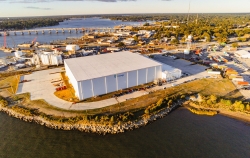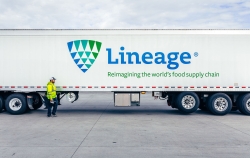Automation is Greening the Food Supply Chain
Automation is – A series on the challenges and opportunities in food logistics.
August 06, 2021
Challenge #3: Sustainability and Energy Efficiency
Sustainability is now a central social tenet.
Earlier this year, President Joe Biden called for cutting U.S. greenhouse gas emissions by 50% to 52% by 2030, on the same day the country rejoined the Paris Agreement. This is a signal to businesses in the United States – and around the world – that sustainability and energy efficiency are more important than ever. Bringing it closer to home, the call to action for the supply chain community is clear – we need to take action and promote environmental sustainability, reduce carbon footprint impacts and drive a greener supply chain.
According to the World Resources Institute, global annual greenhouse emissions have increased over 40% since 1990 – a number that’s continuing to grow (Ge and Friedrich, 2020). The cold chain industry owes sustainability transparency to our consumers, our partners and to future generations. Working together to collectively reduce the industry’s carbon footprint continues to be a critical global agenda item, and we are uniquely positioned to make dramatic impacts on the environment.

81% of supply chain companies are more focused on sustainability today than they were three years ago (Coyote Logistics, 2020)
Recognizing our emissions impact.
Key drivers in multiple sectors of the global economy and the world’s population are demanding change – and the cold chain industry understands that it needs to do its part. A recent study found 81% of supply chain companies are more focused on sustainability today than they were three years ago. And as the Massachusetts Institute of Technology reported in a 2020 study, this shift is partially due to pressure from key supply chain stakeholders that we apply additional efforts toward sustainable operational practices and join the global demand to go green.
The expected result: Supply chain professionals will be a driving force behind the development and execution of their companies’ sustainability programs, searching for ways to create efficiencies and reduce emissions.
And automation is core to our commitment to energy efficiency and sustainability.
Automation in action: Measuring efficiency by degrees.
Conserving energy and achieving efficiencies across our global operations are passions at Lineage Logistics. In our never-ending quest to conserve energy, our Data Science team examined a time-tested practice known as flywheeling to see how it could be improved with a more technology-driven solution.
Flywheeling leverages the frozen contents of a freezer to maintain the optimal temperatures without electricity. During off-peak hours, the warehouse cools products well below their required temperatures. As the facility enters peak hours, the power used to cool the products is greatly decreased as the food’s own temperature is used to keep the food within accepted temperatures. Typically, a manual process relies on humans to “turn things off” during peak times. So, the team asked itself how it can take control of the process by making the process automated without a significant investment.
Over the course of three years, Lineage’s Data Science team developed a patented algorithm that combined machine learning with AI to predict and inform scheduling and energy-related decisions, leading to a significant reduction in its energy intensity and year-over-year energy reduction – staying true to its commitment to reduce waste across its network. The result: Lineage was named a Better Practice Awards winner in 2021 by the U.S. Department of Energy for a third consecutive year, recognizing our outstanding energy-efficient innovations.
Building up instead of out.
Outside of the freezer, automated processes decrease the amount of heat entering a building. At a manual warehouse, an entire forklift must pass through the doors, but at an automated warehouse only a pallet must fit through the doors. In addition, a taller building reduces the heat entry via the roof relative to the product it stores. Such a decrease in heat infiltration decreases the demand on the refrigeration system itself, directly decreasing the energy cost. It further allows the warehouse to maintain the temperature for a longer time, increasing the benefits of flywheeling. Building up instead of out not only reduces our physical footprint but can also reduce our energy usage.
Implementing environmental sustainability and greatly reducing the cold chain’s carbon footprint are essential components of the cold chain’s future. By taking a closer look at time-tested practices and infrastructure, and investing in technology and talent to improve them, we can work towards a greener food supply chain.
In Challenge #2 we established that by advancing the technology we use in our operations, we can alleviate the impact of a labor shortage and keep the food supply chain moving. Next in the series, we’ll look at ways to promote sustainability through eliminating food waste and optimizing food safety.
(2020, October 1). New Study Reveals 81% of Companies More Focused Today on Sustainability. [Press Release]. Coyote.com. https://resources.coyote.com/source/supply-chain-sustainability-press-release
MIT Center for Transportation & Logistics and Council of Supply Chain Management Professionals. State of Supply Chain Sustainability 2020. Cambridge, MA: MIT Center for Transportation & Logistics. 2020. https://ctl.mit.edu/sites/ctl.mit.edu/files/2020-09/State_Supply_Chain_Sustainability_MIT_CTL_CSCMP_0.pdf


